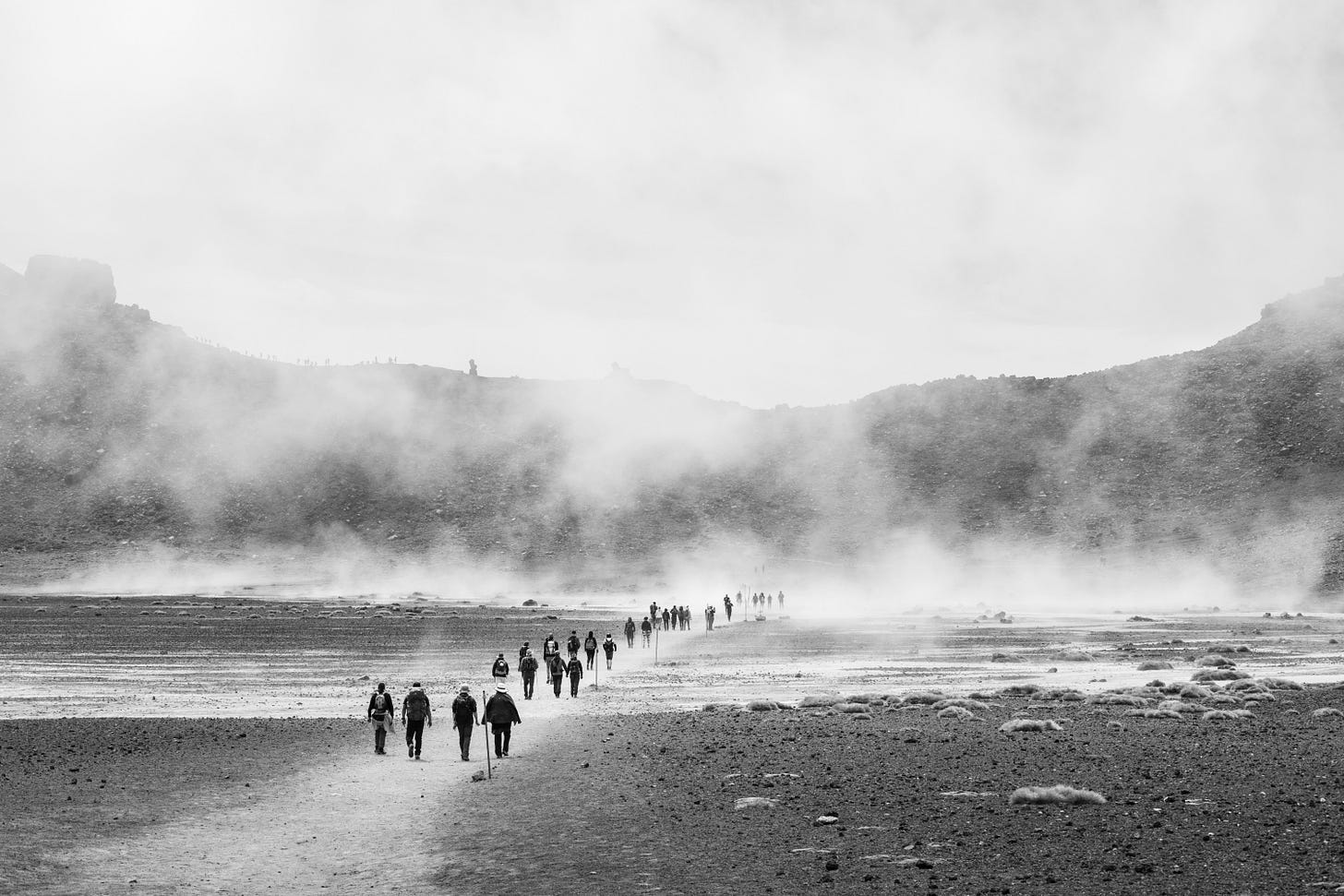“No One Leaves Home Unless Home Is the Mouth of a Shark”
Borders, Exile, and the Violence of Migration Control
In the 2024 Academy award nominated film Io Capitano, Matteo Garrone delivers a story of migration so visceral it sears into the viewer’s conscience. Through the eyes of Seydou, a Senegalese teenager pursuing the dream of Europe, we witness a boy fueld by hope leave home on a physical journey that quickly descends into lawlessness, into ungoverned pain, into a world that mimics—with haunting familiarity—the cycles of brutality that once shaped the darkest chapters of modern history.
It is the sound that stays with the viewer: the roaring wind of the desert, the screaming in the detention camp, the silence of the sea. Seydou’s journey echoes that of so many who flee—not because they want to, but because they must. And in echoing their journey, Io Capitano makes it impossible to look away. As the camera lingers on his sand-covered face or his trembling hands in a Libyan torture chamber, we are asked a question that echoes long past the credits: What kind of world punishes the pursuit of life, liberty and happiness?
The Modern Odyssey of Asylum
Seydou’s harrowing odyssey, told with the raw truth of testimonial cinema, resonates painfully in the current American context. Daily, migrants journey through deserts, pay smugglers, survive state and stateless violence, and face death at every border. But the cruelty does not end upon arrival. Many who arrive to fulfill their European or American dreams are first thrust into filth & squalor, indentured servitude, or are trafficked for drugs, sex, money. To leave a home in search of a better life is, for many, a circuitous path of dangerous hurdles. And then, after the journey, the legal and other obstacles, the resettlement, the assimilation into another culture—one reaches a modicum of stability, of success even. And then comes immigration enforcement (ICE in the US).
We’ve now likely all heard the story of Kilmar Abrego Garcia, a legal resident of the United States who was abducted and deported to El Salvador in 2025 despite ongoing protections under the Deferred Action for Childhood Arrivals (DACA) policy and numerous legal appeals.
Abrego Garcia was pulled over on March 12 outside an IKEA in Baltimore while driving with his son. According to court records, an ICE agent called his partner and told her she had ten minutes to retrieve their child or child protective services would be summoned.² Within hours, he was deported to El Salvador—a country he hadn’t seen since he was a toddler—and was placed in CECOT, a site architected to destroy the human mind, body and spirit. A place where El Salvador's justice minister once described that “…the only way out is in a coffin.”
I do not know anything about Kilmar Abrego Garcia—the allegations of gang affiliation, nor have any addition notes on his character. And you know what? None of that matters. He is a man who was abducted by ICE with the full backing of the current Presidential administration—without due cause. This is the only fact that matters in his case—because if it can happen to him, it can happen to anyone. His case is not an aberration. It is one among many in a systematic campaign of dehumanization—a policy-by-force doctrine that strips individuals of rights, family, and home, cloaked in the rhetoric of “security.” An error, the U.S. government later claimed. But the error had already become a sentence. An act both violent and illegal, bearing resemblance to renditions, the term once reserved for extrajudicial transfers in the War on Terror.³
Violence at the Border of Law
The rhetoric around immigration enforcement in the U.S. often conceals the brutality of its execution. In New Bedford, Massachusetts, ICE agents surrounded a family vehicle and used a hammer to shatter the driver’s side window, forcibly removing Juan Francisco Mendez while his wife, Marilu Domingo Ortiz, filmed the scene. He was not even the person they were seeking. But the window still broke, the arrest was made, and the violence remained. These are not isolated errors in service to public safety—they are the choreography of a system designed to punish presence. This is state sanctioned terror.
The American Civil Liberties Union (ACLU) and Human Rights Watch have documented hundreds of cases of racial profiling, unlawful detainment, family separation, and physical abuse by ICE agents in recent years.⁵ These acts occur in daylight, in neighborhoods and parking lots, bearing no trace of accountability. In a 2022 report, the Office of the Inspector General concluded that ICE facilities were routinely found to lack adequate medical care, violated pandemic protocols, and used solitary confinement arbitrarily—including on transgender detainees.⁶
“It Was a Knock in the Night”
One cannot watch ICE raids, especially those that involve pre-dawn arrests, on-street kidnappings, and door-smashing, without hearing the historical echoes. In Nazi Germany, the Gestapo operated under a similar logic: those who posed a “threat” to the state—defined often by race, identity, or ideology—could be removed without trial, legal defense, or notice. The infamous Nacht und Nebel (Night and Fog) decree authorized disappearances, intended to leave families confused, terrified, and silent.
The United States is not Nazi Germany (yet). But the tools of fear are remarkably similar. Pre-dawn raids. Families separated. Legal protections ignored. Communities surveilled. Resistance criminalized. And much like in 1940s Berlin, many neighbors watch from behind curtains, unsure whether to speak, unsure if they’ll be next.
This fear extends all the way to Capitol Hill. As Senator Lisa Murkowski recently admitted, “We are all afraid,” speaking to the climate of political retribution. “I am oftentimes very anxious myself about using my voice, because retaliation is real. And that’s not right.”⁷ In a system where silence is rewarded and dissent is punished, complicity becomes structural.
Migration as a Human Constant
The movement of people is not a crime. It is a rhythm as old as the human species. As Warsan Shire writes, “no one leaves home unless / home is the mouth of a shark.”⁸ In Io Capitano, we see this embodied in Seydou’s desire—to leave behind Senegal to become someone. A musician. A man of value. The “journey to Europe” becomes a stand-in for a future uncorrupted by poverty or fear. But the reality of arrival is far from salvation. He does not make it to Europe. His journey ends offshore, suspended between life and border, body and exile.
So too in America. The border is imagined as a wound—where one must prove their worthiness through suffering. We see this in the stories of children held in cages, of pregnant women shackled during labor, of transgender asylum seekers raped in detention and then deported to countries where they are at risk of death.⁹
According to a 2021 report by Physicians for Human Rights, many asylum seekers deported by the U.S. face immediate threats of violence upon return, yet deportations continue, often expedited and conducted without transparency.¹⁰
There is a paradox at the heart of American immigration. The country markets itself as a beacon of freedom and opportunity—yet builds its borders to repel, detain, and erase those who dare to believe in it. In Io Capitano, Seydou never reaches the European dream, but his belief in it nearly costs him everything. The dream is a mirage, and the mirage is cruel.
The American version of this is just as stark. The Statue of Liberty says, “Give me your tired, your poor,” but at the southern border, families are teargassed. In courtrooms, toddlers appear without representation. The dream mutates into a lie—one enforced at gunpoint.
And yet, people still come. Like Seydou, like Kilmar Abrego Garcia, like so many who risk everything for a place where their children might live freely. Their perseverance, in the face of militarized borders and moral indifference, is a kind of resistance.
What We Must Remember—and What We Must Do
This is not a policy debate. This is about lives—lives that are undocumented, not invisible; lives that are complex, not criminal. It is about how we respond to suffering not when it is easy, but when it is costly. When asked why he wanted to reach Europe, Seydou in Io Capitano doesn’t talk about money. He talks about music. About freedom. About dignity. He talks about life.
So what do we do, those of us still safe enough to ask the question?
We protect our people. We memorize legal hotlines. We show up to court hearings. We challenge ICE when they appear in our neighborhoods. We witness. We film. We speak. We ask the questions. We share information. We stand tall.
We protect ourselves. We build circles of care. We breathe. We disconnect. We cry in safe places. We do not confuse burnout with activism. We do not let despair rot our capacity to love or fight. We remember that rest, too, is an act of resistance.
We refuse silence. We organize. We write. We remind ourselves that resistance does not always wear capes—it sometimes brings juice to a protest, or signs a petition, or holds a sign on the street, or watches a neighbor’s kid while they meet with their immigration lawyer. Meet your neighbors. Say hello to passers by with an open heart.
Above all, we remember: the beating heart of humanity, of empathy, of the resilience of the human spirit and the magic and power of global community. United we stand.
Footnotes
American Immigration Council. (2025). Due Process Denied: How U.S. Immigration Agencies Routinely Violate Constitutional Rights.
Ducharme, J. (2025, April 16). A Man Was Deported in Error. Now He’s in Prison in El Salvador. TIME. https://time.com/7276642/kilmar-albrego-garcia-error-deportation-el-salvador-prison-supreme-court-return-ms-13
Paglen, T. (2006). Torture Taxi: On the Trail of the CIA’s Rendition Flights. Melville House. This book documents the U.S. government’s use of extrajudicial transfer (“rendition”) during the post-9/11 era, drawing a parallel to the extralegal deportation of Kilmar Abrego Garcia.
Hall, L., & Mutasa, T. (2025, April 16). Video shows ICE agent smash window to detain man in Massachusetts. Attorney says they have wrong person. CBS News. https://www.cbsnews.com/boston/news/video-ice-agent-smash-car-window-new-bedford-massachusetts/
Human Rights Watch. (2022). United States: Systematic Abuses by ICE.
U.S. DHS Office of the Inspector General. (2022). Concerns About ICE Detainee Treatment and Care.
Broadwater, L. (2025, April 17). Murkowski Says Lawmakers Fear Retaliation. The New York Times. https://www.nytimes.com/2025/04/17/us/politics/lisa-murkowski-trump.html
Shire, W. (2015). “Home”, in Teaching My Mother How to Give Birth.
The Guardian. (2019). Shackled During Birth: Immigration’s Hidden Cruelties.
Physicians for Human Rights. (2021). Deported to Danger: United States Deportation Policies Expose Migrants to Death and Harm.
Additional resources
Finley, B. (2025, April 18). Who is Kilmar Abrego Garcia, the man ICE mistakenly deported? Associated Press. Retrieved from https://apnews.com/article/who-is-abrego-garcia-e1b2af6528f915a1f0ec60f9a1c73cdd
Correal, A. (2025, April 19). El Salvador’s President Sees Opportunity in Trump’s Deportations. The New York Times. Retrieved from https://www.nytimes.com/es/2025/04/19/espanol/america-latina/cecot-prision-el-salvador-bukele.html
Ellement, J. R. (2025, April 18). New Bedford man detained by ICE agents was not the person they were seeking, lawyer says. The Boston Globe. Retrieved from https://www.bostonglobe.com/2025/04/18/metro/new-bedford-ice-detained-husband/
Vega, C. (2025, April 6). What records show about the migrants sent to Salvadoran mega-prison. CBS News. Retrieved from https://www.cbsnews.com/news/what-records-show-about-migrants-sent-to-salvadoran-prison-60-minutes-transcript/






I like how put it. “Not because they want to, but because they must.”
Beautiful, powerful, tragic.